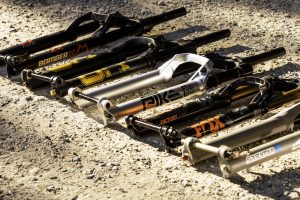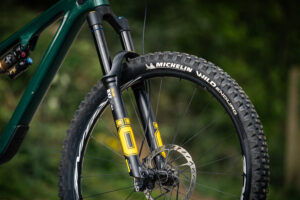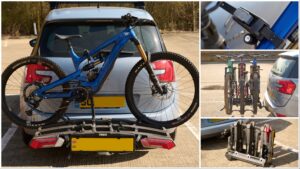More travel, more progression, more geometry adjustment, more sizes - the Trek Fuel EX gets the Oliver Twist makeover.
Trek Fuel EX 9.9 first ride review
Trek has launched a brand new version of the Fuel EX trail bike, and with it a ton of new features and updates to address pretty much any quibble you had with the old bike. We’re talking about: a chip to let you tune the progression of the shock; head angle adjustment to complement the existing Mino Link; size specific chainstays; downtube storage across the whole range; more travel; and loads more.
It was a great bike before, a bike test winner in fact and one of the best full suspension mountain bikes we’d ever ridden. The new bike promises to take that a stage further.

Fuel EX frame is a work of art, with oversized carbon tubing and a liquid custard paintjob
Need to know
- Head angle goes as slack as 63.5° thanks to new headset cups that complement the Minnow Link chips
- Longer, lower and slacker geometry, with a steeper seat tube angle for better pedalling
- Travel is up by 10mm from the old bike, to 140mm front, 150mm rear
- Eight sizes, 29in wheels predominate, with 27.5in on the smallest sizes
- New progression chip lets you tweak the shock position and add more platform
- Fuel EX can take almost any shock on the market, Trek says, coil and air
- Six models in the range, alloy and carbon: from £3,300 for the Fuel EX 7 to £11,750 for the 9.9 XX1 AXS

EX or EXe… Spot the difference
First though, how similar does the new Fuel EX look to the also-new Fuel EXe e-bike? They even sport the same travel. This is deliberate; Trek wants you to make a choice between the bikes based on how much help you want, not on how the bikes look, how much travel they bring or the ride feel they deliver.
That means the new Fuel EX looks like an e-bike that in turn looks like a regular bike. Whaaat?!
10mm more travel
So to the new Fuel EX. Trek has boosted the travel by 10mm, taking it to 140mm rear and 150mm front. Because who doesn’t want more travel? Also, Trek’s thinking is that the Fuel EX can be more than just a trail bike if it wants, so there are options to increase the travel further, swap the wheel sizes and even fit a different shock.

The Fox 36 fork looks positively dinky on the new Fuel EX frame
Longer, lower, slacker, steeper
LLSS is the new LLS. Just like on the old bike, the new Fuel EX comes with Minnow Link, two little flip chips on the rocker link that let you change the BB height and head angle. That means the head angle is down to 64.5° in the slack setting, a full degree slacker than when we tested the old version of the bike.
The BB height is lower too – on paper it’s just 2mm, but with 10mm more travel to contend with this means at sag the bike will hug the ground more closely. The Minnow Link changes that BB too of course, raising or lowering it by 8mm.

Minnow Link is now more useable, with a properly low setting that drops the BB and slackens the head angle
All told, the new bike’s high position gives it the same geometry figures the old bike commanded in its low position, with the longer fork slotted into both bikes. This makes the Minnow Link a lot more usable now, you won’t just be slinging it into low position and forgetting about it.
Trek has taken a leaf from the Specialized brochure, and gone with adjustable headset cups, so you can tune the head angle +/- 1°. That’s useful if you want to keep the bottom bracket the same height, and independently change your head angle.
It works like this – the upper cup just drops in, and you turn it 180° to steepen or slacken the angle. The lower cup is more fiddly, it needs to be pressed in but the bike comes with it installed. The cups have notches and laser-engraved guides to help you install them straight.

Bontrager carbon wheels are excellent, but the SE5 Team Issue tyres lack bite
What, no mullet?
The Fuel EX remains a 29in wheel bike in most of the eight sizes on offer (XS-XXL). The exceptions are the diddiest XS which is 27.5in and the S which you can get as a 29er or 27.5in. There’s nothing stopping you putting a 27.5in wheel in the back of the Fuel EX though, and Trek actually endorses this, with suggestions on how to set it up. Put it in the high mode, and adjust the air assembly in the fork to give you 160mm travel to keep the BB from getting pedal-bonkingly low, it says.
How big?
Sizing has grown with the new bike, each size is 10-20mm bigger in the reach measurement. Fortunately, to compensate for that longer front end, Trek has built a longer back end too – the chainstays are at last size specific and range from 435mm on the XS bike up to 450mm on the XXL. The seat tube is steeper this time around too, for a better climbing position, so in theory when you’re sat down and pedalling you won’t notice the extra length in the bike because you’ll be shunted forwards.
One final word on geometry, there’s now a chart on the Trek website to let you see how the geometry will change when you tinker with the adjustment hardwear.

Trek has introduced more progression, should you want it, thanks to a flip chip
The suspension
Here’s the big change, in my mind. If the old bike had a flaw it was that the suspension didn’t have much of a platform. Instead it was sensitive off the top. On reflection, is that really a flaw in a trail bike? We didn’t think so, but plenty of riders are looking for more progression, so Trek has added some. Or more accurately, the ability to add some, with a progression chip.
The new frame lets you adjust the position of the shock by moving the lower mounting point further aft and increasing the leverage rate, building in more of a platform. And for those who liked the suspension feel just fine before, just leave the chip unchanged.
If looks could thrill
The Fuel EX looks plenty like its predecessor, but there are some subtle changes conjured up by Trek to make room for all the features included, like the progression chip. The shock has shifted further forward, the idea being to give it more space and allow for every shock on the market to fit in there. “If it’s out there it’ll fit on this bike,” Trek says.

Trek’s made more space around the shock, meaning you’ll be able to fit pretty much any shock going
In practice that means every shock from Fox, RockShox, DVO, Push and MRP can be fitted to the Fuel EX. There are exceptions, largely if you’re trying to fit one of the really big reservoir shocks into a size small frame, Trek seys.
The bike has moved to a 34.9 seatpost now, which is stiffer and more reliable too, particularly at the 200mm length in XXL bikes, while frame storage now comes on the alloy bikes as well as carbon frames. Inside both carbon and alloy bikes is fully guided internal cable routing. Outside is a full length, removable plastic guard on the downtube.

Top end Project One bike is a playboy price, just under £12,000, but there are plenty of better value bikes in the range
The range
With six models in the range, eight sizes, and two different wheel sizes, the Fuel EX is a distributor’s nightmare… and a rider’s dream.
The entry level Fuel EX 5 isn’t new; it uses last year’s frame, meaning you get 130/140mm travel and entry level components. The 7 is an alloy bike and uses the new chassis and its new downtube storage and retails at £3,300, while the 8 is still alloy but introduces 36mm stanchion forks and the Float X shock for £4,000.
There are three Fuel EX 9 models, and all use a full carbon fibre frame. The 9.7 is the entry level carbon bike and costs £4,800 with a Shimano SLX/XT drivetrain. Step up to 9.8 and you gain XT or GX AXS shifting for £6,850 or £7,450 respectively, while the top end 9.9 features full XTR or XX1 AXS at £9,900 or £11,750.

Cut the bars down and let some air out of the tyres and the Fuel EX takes off
How it rides
The Fuel EX 9.9 comes with a one-piece, carbon-fibre bar and stem, and at 830mm (including grips) it’s way too wide and flexy to ride well. I lopped it down to 780mm and at a stroke that cured the front end problems I’d been having – chiefly, the scary undamped sensation when pitching into steep corners. The Bontrager tyres have been hard to get on with too, at 2.5in wide and without pronounced side lugs it’s hard to make them bite into soft terrain. I dropped the pressures down to improve the feel… and I mean way down, 19psi in the front and 21psi in the rear to make the ride less pingy and more predictable. I probably could have gone further too, given there was no squirm even that low, while the sidewalls proved effective at fending off pinchflats.
That done, the bike was free to ride like its true self. The Fox Float X shock is supple off the top and bobs a little going uphill, but the EX is an expert climber probably because it gets great traction from the active shock, while the steep seat angle and long chainstays pitch you forwards. That aggressive seat angle disguises just how big this XL bike is too, it has a huge 515mm reach making it one of the longest bike’s I’ve ever ridden. In fact, I could probably step down a size, although there’s a huge jump down to the Large with its 485mm reach. All told though, the bike feels compact enough when sat down and pedalling yet long in reach when out of the saddle.

Big sizing puts you in the ideal position on the bike for maximum confidence
The Fuel EX retains the stiff and bombproof feel of the old bike, it’s very direct and trails have a hard time deflecting it off course. The carbon frame has a great, damped feel, it’ll bulldoze its way across off-camber sections and let you set up wide, yet somehow manages to cushion you from the worst of the trail chunder you’re trucking over.
The suspension is supple and works well right off the top, but I did have to wind off all the low speed compression damping to make it come alive, which makes me think it’s overdamped. Fully open though, there’s plenty of traction in the dry and loose conditions I rode in, with enough support for trail riding.

The Fuel EX is a precision ride, able to pick through the roots or dance over them
When I back-to-backed the EX with the EXe the e-bike felt more like an enduro bike, with better suspension and simply more control on the trail. This is really interesting because both bikes have identical components and suspension travel, and both felt slightly overdamped. With the right shock I’m perfectly prepared to believe the Fuel EX could work well as an enduro bike then – the frame can certainly handle it.
- Best mountain bikes: the ultimate trail, cross-country and enduro bikes
- Best mountain bike helmets: a bunch of brilliant brain savers
- The Trek Fuel EXe review
Verdict
Trek knows how to make a well finished bike, and the Fuel EX is the latest demonstration of this. It’s ridiculously well finished, everything from the down tube storage to the new steerer-hidden BITS multitool and the bolted-on (not glued) chainstay protector is solid and reliable. The Fuel gets better in every iteration, the only problem is now you can get it with a motor in… too tempting for some riders, myself included.
















